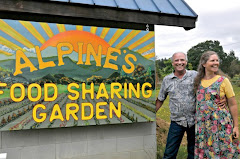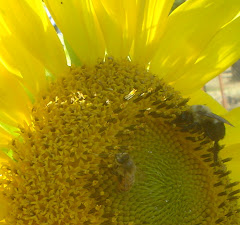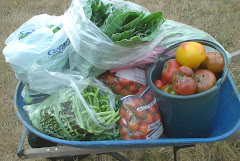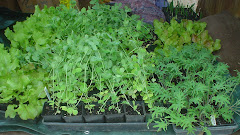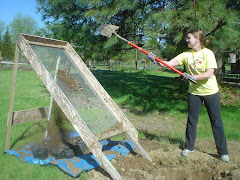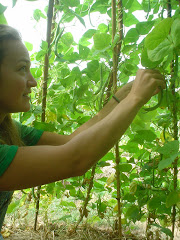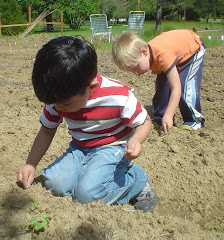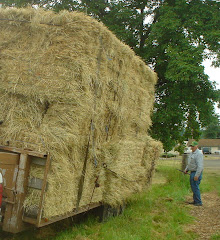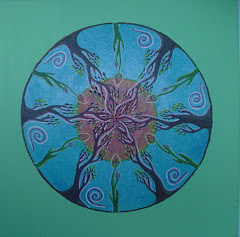 |
| Deep mulching produces a bounteous harvest! |
Here in the Sharing Gardens we practice a style of gardening known as "deep mulching". Just as it is rare to find bare soil in nature, in our gardens you won't find much exposed soil either. We use the materials that are easily available in our area (grass clippings, leaves and spoiled hay) and let nature do the work of increasing the garden's fertility. People who raise livestock such as cows, goats, chickens and rabbits know how important it is to give appropriate food, water and shelter to keep their animals healthy. In turn, these animals produce by-products that are beneficial to the people who care for them, not the least of which are the nutrient-rich manures used as the basis for many commercial fertilizers. In the Sharing Gardens, we tend to "livestock" on a slightly smaller scale. Worms, fungi, beneficial insects and bacteria are the micro-livestock we care for with our heavy mulching. They, in turn, provide a natural balancing of the soil along with castings and other "waste products" that feed the plants' rootlets right where they need it most.
 |
| Mulching feeds your "micro-livestock" |
|
In these first years of establishing new garden sites in Alpine and Monroe, we also use a high-quality organic fertilizer, our own worm-castings compost, and rabbit and llama-doo applied judiciously to the plants that need a boost. But we don't apply any single concentrates of nutrients such as lime or gypsum as we have found through years of gardening experience that a garden's soil can get seriously out of balance through the application of these concentrates.
What materials make good mulch? It is best to choose materials that are readily available in your local area. Urban gardeners may find that leaves and grass clippings are easiest to come by. Many cities will actually dump a load of
leaves for personal use if you have an adequate drop-site. Do be aware that you can't be 100% sure of the
kind of leaves you're getting. There is also likely to be
some residue from oil and other materials from motorized vehicles (though probably not enough to be very concerned about). You'll need to be sure and use good gloves in distributing city-leaf piles as its possible that broken bottles or other sharp trash could be mixed in. Hand-raking leaves is our favorite method for gathering this valuable resource. Leaf-raking gives you a great work-out without being too strenuous (we call it "rakey" therapy -ha.) You can use tarps to haul the leaves to your garden, or bag them in leaf-bags. Sometimes we have stored leaves in rings we crafted from fencing, or just made a deep pile and tarped it for the winter. This latter option produced very rich, yummy, decomposed leaf compost by the following spring. The thinner the leaf, the easier it breaks down. Maple is our favorite. Oak takes a long time to break down and we wouldn't recommend using it unless you mix it with other types of leaves. Fruit-tree leaves are also great.
Don't ever use walnut leaves as they have natural substances in them that are poisonous to plants and will destroy your garden's fertility.
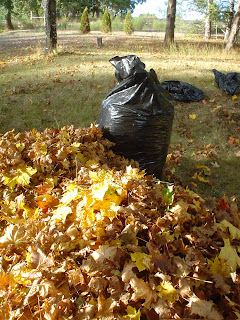 |
| Maple leaves make excellent mulch |
If you live in, or near the country,
spoiled hay makes a great mulch. Many farmers have hay from previous seasons that has become wet or moldy or otherwise unsuitable to feed to their livestock They will usually be glad to have you haul it away for free, or very little per bale. If you don't have a trailer, you might be able to arrange for the farmer to bring it to you if you give him something for his gas and time.
Another rural source for excellent mulch is to clean out the stalls of goats, sheep, cows or horses. It's ideal if their bedding material is straw. If wood chips or saw dust is their bedding, you'll only want to use it if its been composting for a year or more. The heavy balance of carbon in the wood-products can actually leech nitrogen from your soil..
 |
| A delivery of spoiled hay |
When to mulch? In the cycle of a year's gardening, there are two main times for a mulch "push". At the end of harvest, when you're putting your garden to bed, if you have a large enough quantity of grass clippings, raked leaves or animal bedding from cows, goats, sheep or horses that has manure mixed in, you can apply this liberally and roto-till it into the ground. This gives you the whole winter for the micro-livestock to digest it in time for spring planting. It is not a good idea to till your mulch into the ground in the spring time because the "browns", the more woody/cellulose aspects of the mulch that are high in carbon will bind with the nitrogen in your soil and effectively rob it from your spring seedlings if tilled in too close to their planting.
The second cycle of mulching begins in the spring and continues throughout the summer as you plant your garden rows. In our gardens, we have used a roto-tiller to loosen the beds and then mounded them into raised beds by hand or with a tractor. In future years, as the soil improves through the addition of organic matter (hay, leaves etc), and the worm colonies have become well established, we may be able to maintain these beds just using a broadfork (a human-powered tilling tool that is less disturbing to the soil).
Why mound the soil? We take the time each year, to mound the soil into raised beds for several reasons. As you can see from the photo, in the wetness of the Pacific NW spring, it keeps the roots from drowning by raising them above the water table. Also, if your rows run east to west, the whole south side of them faces the sun which can significantly warm the soil temps; another great advantage to most seedlings' early growth. The mounded soil doesn't ever get walked on so, over several years, if you maintain your rows in the same spaces, this soil becomes very light and fluffy, with good "tilth".
 |
| Advantages of raised beds... |
If you're using all that hay and grass clippings, what about weeds? This is a question we get asked a lot. Bringing a whole bunch of hay into your garden may not seem like a good idea as you also bring a bunch of weed seeds that can then germinate in your garden soil. They key is in applying enough mulch, soon enough. In our Alpine plot (80' x 100'), in the first year, our friend was able to till the ground a good 8" deep thus killing all the grasses/weeds already growing at the site. We mulched heavy and early and, in the whole season we probably weeded about a five-gallon bucket's worth of weeds out of the whole garden. No kidding. For contrast, in the Monroe site, because of a very wet, cold spring and the urgency of moving ahead and simply getting some things planted before the soil had had time to drain sufficiently for deep tilling, the ground was only tilled about 4" deep. Many of the weeds and grasses were only "scalped" and came back strong in the garden beds, so we have pulled
many wheelbarrows full of weeds out of that garden. But the weeds are only coming up in the garden beds themselves. In the pathways that are heavily mulched, the weeds exhaust themselves before they can grow up to the light. As they die, they become mulch too and their rootlets provide yummy snacks for the worms to follow along as they work the soil.
How much is enough? You want to put enough of the material to keep in the moisture and block the sun from reaching any weeds growing in the paths. Hay bales often naturally break into "flakes". Just lay these in your paths, end to end, without fluffing them (which can scatter seed into your beds) and make it easier for weeds to grow through (5" to 8" is ideal). If you're using dried leaves, they too should be about 6" thick. Grass clippings work best if you put them locally around the base of plants (leave about a 2" gap around the stem of the plant). When applied liberally in the paths they can form a gooey surface that can be quite slick and dangerous to walk on. They also become "felted" or matted down making it harder for water to seep through to the plant's roots. You'll be amazed to see, over the course of a year, that the 8" of mulch you applied in May, June or July, will be almost totally digested (from below) by the following March/April when you begin the spring plantings. Worms travel up to the surface of the soil at night and feed on the mulch, carrying it back down into the soil in their gullets and distributing it as castings throughout your garden.
 |
| Alpine Garden - 10 weeks after breaking ground 2009 |
A summary of the benefits:
- Keeps moisture in (less watering). Though when you water, you must water long and deep to be sure the water penetrates down through the mulch and into the soil. In our Monroe garden, we have gone over two weeks without watering in the heat of August but we watered each section of the garden for over two hours at the beginning of those two weeks. When you're first planting a bed - with seeds or transplants, you need to water more often till the plants are established. To check if you need to water, lift mulch in the paths and check for moisture level in the soil. You can often see red worms and tiny rootlets extending from the plants growing in the beds.
- Keeps weeds down.
- Balances your soil-nutrients (your "micro-livestock" keep things balanced without you having to figure it all out.)
- Moderates day/night temperature fluctuations in the soil.
- Adds organic matter to keep soil from becoming too sandy or clay-bound.
- It's very comfortable to sit or kneel on as you cultivate and harvest your plants. (We had a photographer come to our gardens once and said it was "the most comfortable" garden she'd ever been in!)
Sources for mulch:
- Municipal leaf-gathering
- Raking your own (offer to rake your neighbors' in exchange for keeping the leaves.)
- Farmer's moldy or spoiled hay
- Set up your own collection site: Rural transfer stations appreciate any solution that keeps material out of the landfill. Below is a picture of a collection site Chris established near his farm in northern California.
 |
| A gathering site for mulch donations at the local, rural transfer station. |
Here are some other pictures of our gardens showing the deep mulch technique:
 |
| Another example of how the garden looks--fully mulched--with hay. |
 |
| Tilling in leaves in the fall - so they have time to decompose by spring. |
 |
| The potatoes were mulched first with leaves and we're adding oat-straw in the picture. |
 |
| This was a "lawns-to-gardens" project where we simply scalped the grass from the beds and mulched the lawn path-ways. The plastic on left was placed to "solarize" the grass (kill it in preparation for fall-crop planting). |
 |
| Here Chris is using lettuce that has "bolted" (gone to seed) as mulch in the potato patch. Oat straw was then placed over it. |
 |
| Fun in a leaf ring! (Robin, Chris' son in a "nest" of leaves1996) |
Please read our post about
Herbicide Contamination of Compost, Manure and Mulch

 Tomatoes: 49 pounds
Tomatoes: 49 pounds








